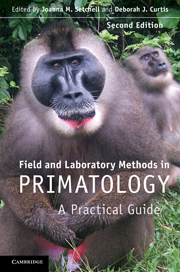Book contents
- Frontmatter
- Contents
- List of contributors
- Foreword by Robert D. Martin
- Introduction
- 1 An ethnoprimatological approach to interactions between human and non-human primates
- 2 Habituating primates: processes, techniques, variables and ethics
- 3 Habitat description and phenology
- 4 Geographical information systems and remote sensing
- 5 Monitoring local weather and climate
- 6 Survey and census methods: population distribution and density
- 7 Trapping primates
- 8 Handling, anaesthesia, health evaluation and biological sampling
- 9 Morphology, morphometrics and taxonomy
- 10 Marking and radio-tracking primates
- 11 Field experiments with non-human primates: a tutorial
- 12 Feeding ecology, frugivory and seed dispersal
- 13 Dietary analysis I: food physics
- 14 Dietary analysis II: food chemistry
- 15 Collecting arthropods and arthropod remains for primate studies
- 16 Recording primate vocalizations
- 17 Photography and video for field researchers
- 18 Chronobiological aspects of primate research
- 19 Thermoregulation and energetics
- 20 Field endocrinology: monitoring hormonal changes in free-ranging primates
- 21 Collection, storage and analysis of non-invasive genetic material in primate biology
- 22 Tips from the bush: an A–Z of suggestions for successful fieldwork
- Index
- References
16 - Recording primate vocalizations
Published online by Cambridge University Press: 05 June 2012
- Frontmatter
- Contents
- List of contributors
- Foreword by Robert D. Martin
- Introduction
- 1 An ethnoprimatological approach to interactions between human and non-human primates
- 2 Habituating primates: processes, techniques, variables and ethics
- 3 Habitat description and phenology
- 4 Geographical information systems and remote sensing
- 5 Monitoring local weather and climate
- 6 Survey and census methods: population distribution and density
- 7 Trapping primates
- 8 Handling, anaesthesia, health evaluation and biological sampling
- 9 Morphology, morphometrics and taxonomy
- 10 Marking and radio-tracking primates
- 11 Field experiments with non-human primates: a tutorial
- 12 Feeding ecology, frugivory and seed dispersal
- 13 Dietary analysis I: food physics
- 14 Dietary analysis II: food chemistry
- 15 Collecting arthropods and arthropod remains for primate studies
- 16 Recording primate vocalizations
- 17 Photography and video for field researchers
- 18 Chronobiological aspects of primate research
- 19 Thermoregulation and energetics
- 20 Field endocrinology: monitoring hormonal changes in free-ranging primates
- 21 Collection, storage and analysis of non-invasive genetic material in primate biology
- 22 Tips from the bush: an A–Z of suggestions for successful fieldwork
- Index
- References
Summary
INTRODUCTION
Ornithologists have been exploring the possibilities and the methodology of recording and archiving animal sounds for many decades. Primatologists, however, have only relatively recently become aware that recordings of primate sound may be just as valuable as traditional scientific specimens such as skins or skeletons, and should be preserved for posterity (Fig. 16.1). Audio recordings should be fully documented, archived and curated to ensure proper care and accessibility. As natural populations disappear, sound archives will become increasingly important (Bradbury et al.,1999).
Studying animal vocal communication is also relevant from the perspective of behavioural ecology. Vocal communication plays a central role in animal societies. Calls are believed to provide various types and amounts of information. These may include, among other things: (1) information about the sender's identity (e.g. species, sex, age class, group membership or individual identity); (2) information about the sender's status and mood (e.g. dominance, fear or aggressive motivation, fitness); and (3) information about relevant events or discoveries in the sender's environment (e.g. predators, food location). When studying acoustic communication, sound recordings are usually required to analyse the spectral and temporal structure of vocalizations or to perform playback experiments (Chapter 11).
This chapter describes how to record non-human primate vocalizations. We begin with definitions of some technical terms, then provide information on the advantages and disadvantages of various types of equipment (sound recorders, microphones and other equipment).
- Type
- Chapter
- Information
- Field and Laboratory Methods in PrimatologyA Practical Guide, pp. 287 - 304Publisher: Cambridge University PressPrint publication year: 2011
References
- 1
- Cited by



